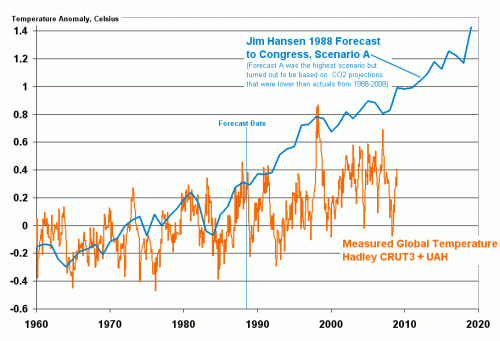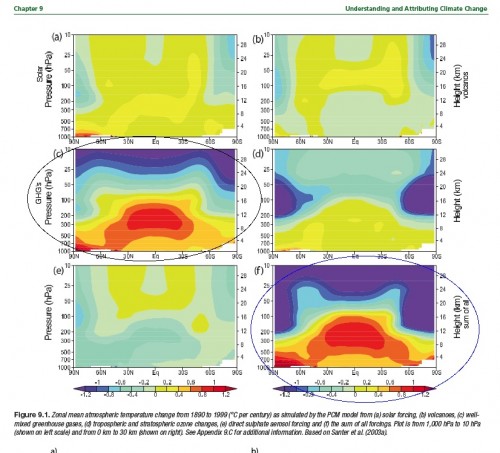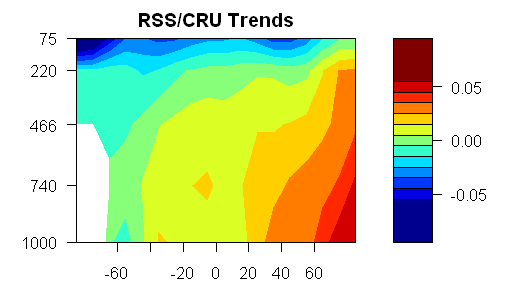I have written a number of times about the “global warming accelerating” meme. The evidence is nearly irrefutable that over the last 10 years, for whatever reason, the pace of global warming has decelerated (click below to enlarge)
This is simply a fact, though of course it does not necessarily “prove” that the theory of catastrophic anthropogenic global warming is incorrect. Current results continue to be fairly consistent with my personal theory, that man-made CO2 may add 0.5-1C to global temperatures over the next century (below alarmist estimates), but that this warming may be swamped at times by natural climactic fluctuations that alarmists tend to under-estimate.
Anyway, in this context, I keep seeing stuff like this headline in the WaPo
Scientists: Pace of Climate change Exceeds Estimates
This headline seems to clearly imply that the measured pace of actual climate change is exceeding previous predictions and forecasts. This seems odd since we know that temperatures have flattened recently. Well, here is the actual text:
The pace of global warming is likely to be much faster than recent predictions, because industrial greenhouse gas emissions have increased more quickly than expected and higher temperatures are triggering self-reinforcing feedback mechanisms in global ecosystems, scientists said Saturday.
“We are basically looking now at a future climate that’s beyond anything we’ve considered seriously in climate model simulations,” Christopher Field, founding director of the Carnegie Institution’s Department of Global Ecology at Stanford University, said at the annual meeting of the American Association for the Advancement of Science.
So in fact, based on the first two paragraphs, in true major media tradition, the headline is a total lie. In fact, the correct headline is:
“Scientists Have Raised Their Forecasts for Future Warming”
Right? I mean, this is all the story is saying, is that based on increased CO2 production, climate scientists think their forecasts of warming should be raised. This is not surprising, because their models assume a direct positive relationship between CO2 and temperature.
The other half of the statement, that “higher temperatures are triggering self-reinforcing feedback mechanisms in global ecosystems” is a gross exaggeration of the state of scientific knowledge. In fact, there is very little good understanding of climate feedback as a whole. While we may understand individual pieces – ie this particular piece is a positive feedback – we have no clue as to how the whole thing adds up. (see my video here for more discussion of feedback)
In fact, I have always argued that the climate models’ assumptions of strong positive feedback (they assume really, really high levels) is totally unrealistic for a long-term stable system. In fact, if we are really seeing runaway feedbacks triggered after the less than one degree of warming we have had over the last century, it boggles the mind how the Earth has staggered through the last 5 billion years without a climate runaway.
All this article is saying is “we are raising our feedback assumptions higher than even the ridiculously high assumptions we were already using.” There is absolutely no new confirmatory evidence here.
But this creates a problem for alarmists
For you see, their forecasts have consistently demonstrated themselves to be too high. You can see above how Hansen’s forecast to Congress 20 years ago has played out (and the Hansen A case was actually based on a CO2 growth forecast that has turned out to be too low). Lucia, who tends to be scrupulously fair about such things, shows the more recent IPCC models just dancing on the edge of being more than 2 standard deviations higher than actual measured results.
But here is the problem: The creators of these models are now saying that actual CO2 production, which is the key input to their model, is far exceeding their predictions. So, presumably, if they re-ran their predictions using actual CO2 data, they would get even higher temperature forecasts. Further, they are saying that the feedback multiplier in their models should be higher as well. But the forecasts of their models are already high vs. observations — this will even cause them to diverge further from actual measurements.
So here is the real disconnect of the model: If you tell me that modelers underestimated the key input (CO2) in their models, and have so far overestimated the key output (Temperature), I would have said the conclusion to this article is that climate sensitivity must be lower than what was embedded in the models. But they are saying exactly the opposite. How is this possible?
Postscript: I hope readers understand this, but it is worth saying because clearly reporters do not understand this: There is no way that climate change from CO2 can be accelerating if global warming is not accelerating. There is no mechanism I have ever heard by which CO2 can change the climate without the intermediate step of raising temperatures. Co2–>temperature increase–>changes in the climate.
Update: Chart originally said 1998 forecast. Has been corrected to 1988.
Update#2: I am really tired of having to re-explain the choice of using Hansen’s “A” forecast, but I will do it again. Hansen had forecasts A, B, C, with A being based on more CO2 than B, and B with more CO2 than C. At the time, Hansen said he thought the A case was extreme. This is then used by his apologists to say that I am somehow corrupting Hansen’s intent or taking him out of context by using the A case, because Hansen himself at the time said the A case was probably high.
But the only difference between A, B, and C were not the model assumptions of climate sensitivity or any other variable — they only differed in the amount of Co2 growth and the number of volcano eruptions (which have a cooling effect via aerosols). We can go back and decide for ourselves which case turned out to be the most or least conservative. As it turns out, all three cases UNDERESTIMATED the amount of CO2 man produced in the last 20 years. So, we should not really use any of these lines as representative, but Scenario A is by far the closest. The other two are way, way below our actual CO2 history.
The people arguing to use, say, the C scenario for comparison are being disingenuous. The C scenario, while closer to reality in its temperature forecast, was based on an assumption of a freeze in Co2 production levels, something that obviously did not occur.



